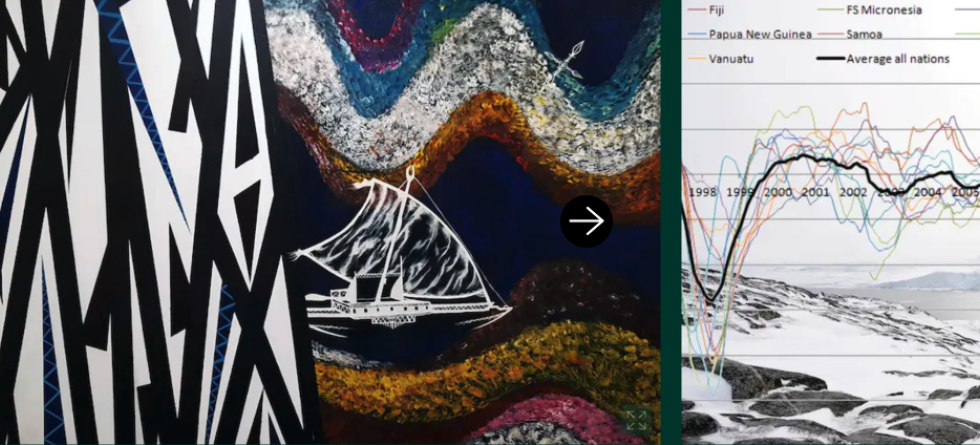Scroll down to see our other events during One Ocean Week.
The exhibition Ocean Stories is part of One Ocean Week, celebrating the barque Statsraad Lehmkuhl's return after circumnavigating the globe.
"Statsraad Lehmkuhl and its crew have sailed around the world, meeting people affected by climate change. In this project we try to find out how people experience these changes. The ocean connects people," says Skade Henriksen, artist and coordinator for the research project Climate Narratives, organizing the exhibition.
Greenland and Fiji are located on opposite sides of the globe, but the ocean connects these two places. Their inhabitants depend on the ocean and are strongly influenced by changes in the climate.
The sound of a rising ocean
In her exhibited piece of video art, Skade Henriksen has used projections of future sea level near Fiji in the Pacific and Disko Bay on Greenland to define movements and sound. She emphasizes that the work is not meant to purely illustrate data or climate change.
"Climate change is a hyper object, too large for the human mind to grasp. One way to communicate something this large, is through art".
When glaciers melt on Greenland, more water enters the global ocean. Still, the changes in the tropics will be more pronounced than in the north. Bars on a monitor show rising seas around Fiji, while the sea level barely changes, or even gets lower, off the coast of Greenland.
Oceanographer Kristin Richter from NORCE and the Bjerknes Centre for Climate Change explains how this mechanism is a question of gravity.
Just like the moon pulls on the ocean and creates tides, heavy continents and ice masses attract water. With the ice disappearing, Greenland becomes less heavy, pulling less water to the region. Locally, the sea level may fall.
"On Greenland the ice disappears, and more land is revealed. On Fiji, land areas are reduced. This piece of work is based on sea level data, but the numbers don't show. A listener will not know what the sound corresponds to in centimeters or meters," says Kristin Richter.
"Sound penetrates the body, and people relate to it differently than to data. In this work you get climate change into your head through earphones", Skade Henriksen adds.
Telling climate stories
The exhibition at Kode consists of works by a total of 28 artists – from Greenland and Fiji as well as Bergen. It will open Friday 14 April at 17. Read more about the opening here.
In cooperation with Litteraturhuset i Bergen the project Climate Narratives also organizes a series of events featuring climate stories from Greenland and the Tropics. During the first event, Tuesday 18 April, young climate researchers from Fiji, Jamaica and Canada will talk about the influence of ice melt and rising sea levels on life in their home towns. Read more about this here.
Note: The event on 18 April has previously been announced to start at 19 – the correct time is 20.
Events during One Ocean Week
The complete program for One Ocean Week is found here.
A selection:
Friday 14 april
Blue foods for health and sustainability. Tasting session in the restaurant Lysverket.
Opening of the exhibition: Ocean Stories, Kode
Tuesday 18 April
Ocean Science Bar – Students in the Pacific
Ocean Futures – an ocean of opportunities
Climate change in the Pacific Islands and the Caribbean: Young voices
Wednesday 19 April
Ocean Science Bar – Ocean, climate and fish
School visits on Statsraad Lehmkuhl
Thursday 20 April
Ocean Science Bar – Food from the ocean
One Ocean – One Pint ... of Science
Throughout the week
Exhibition: Ocean Stories, Kode
Effects of Climate Change on the World’s Ocean. International ocean conference hosted by the Institute of Marine Research.

